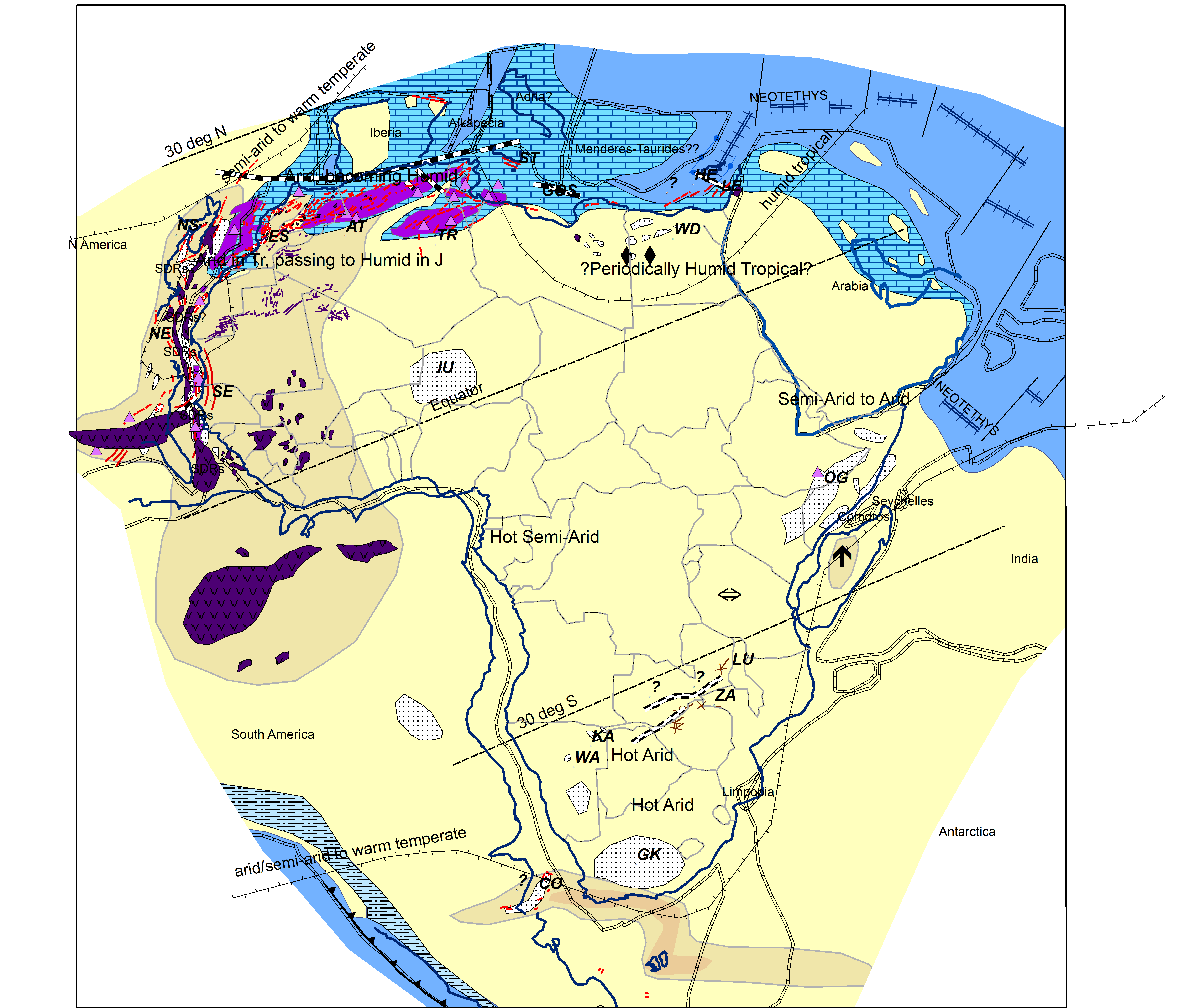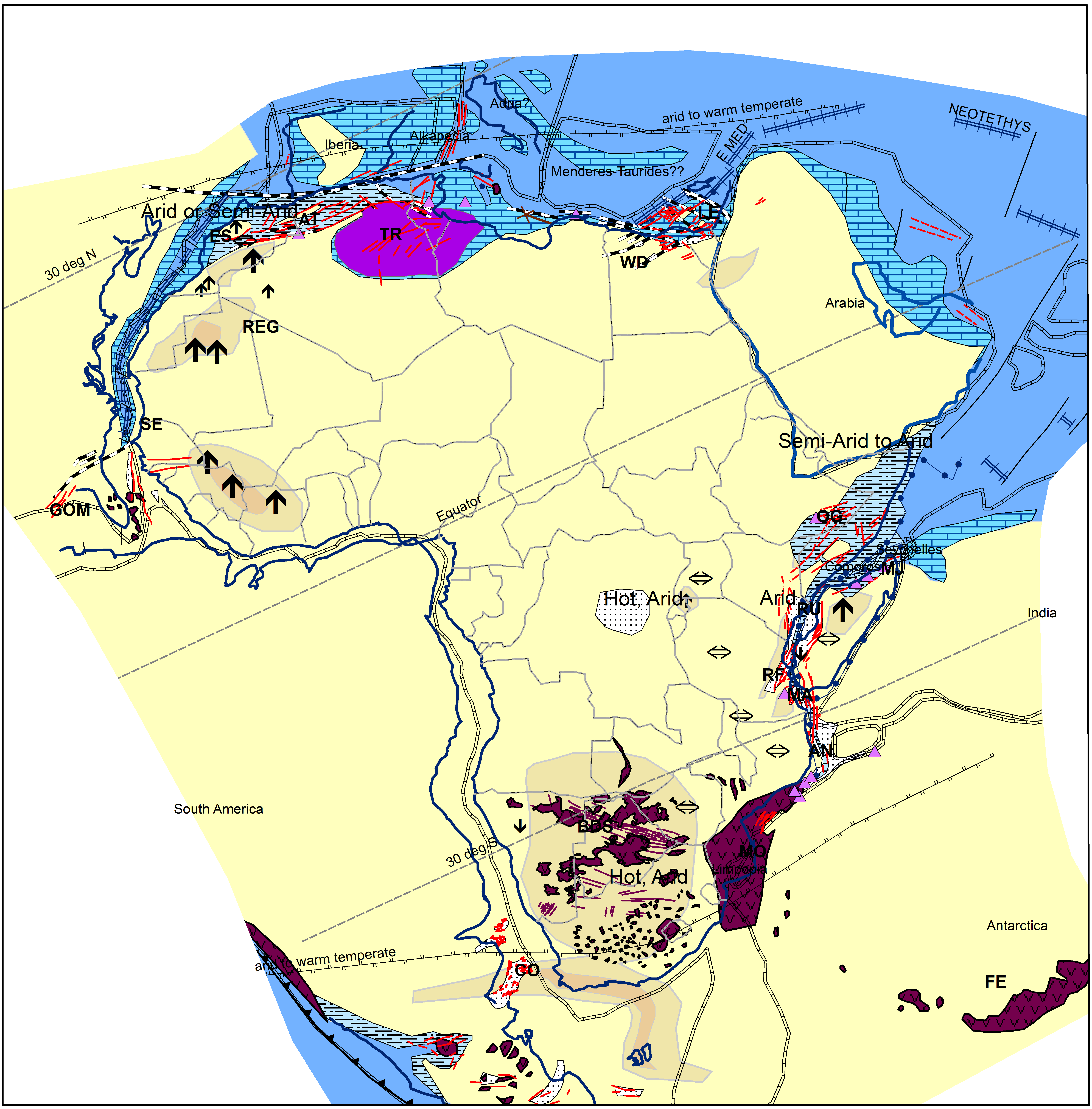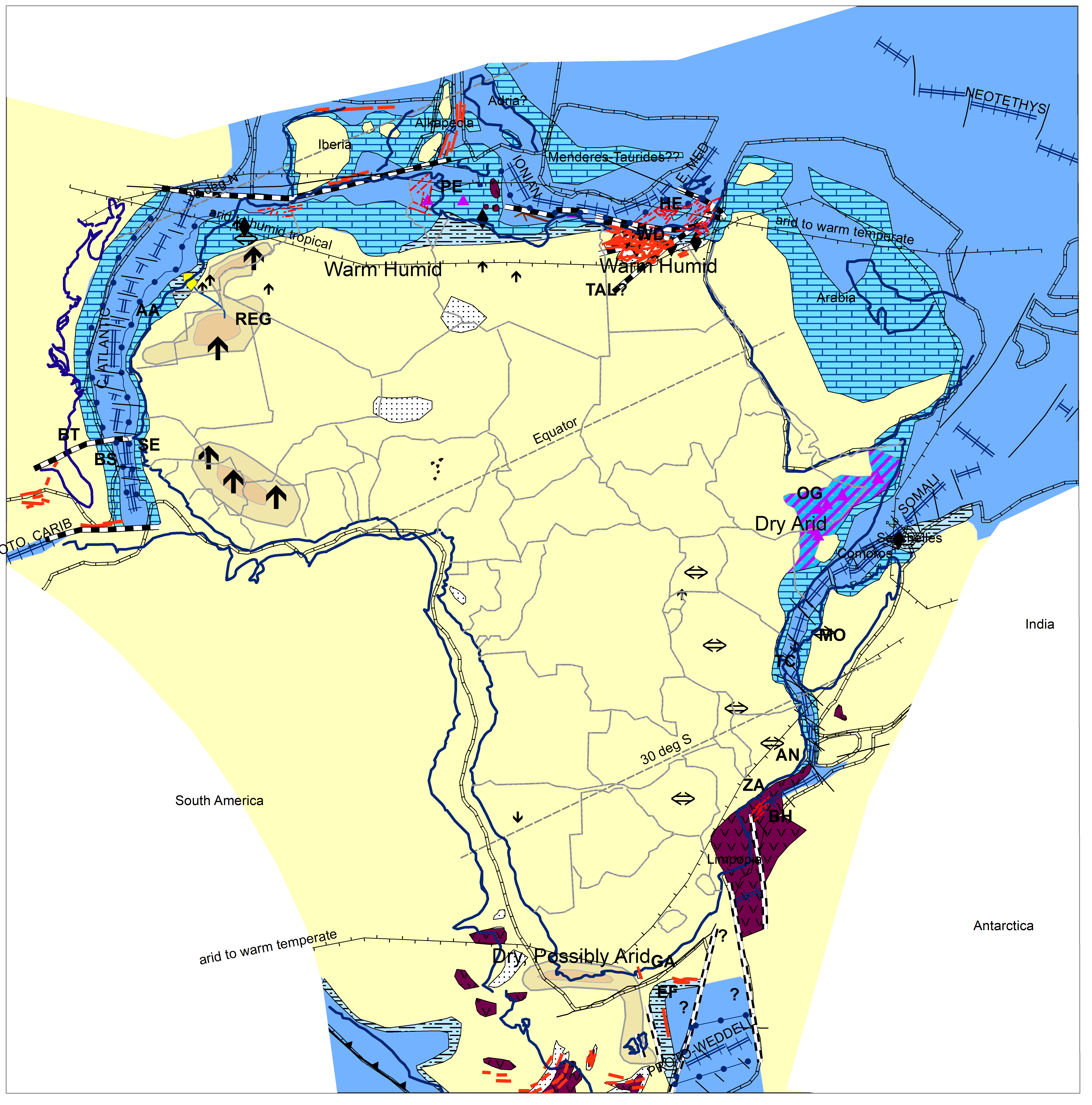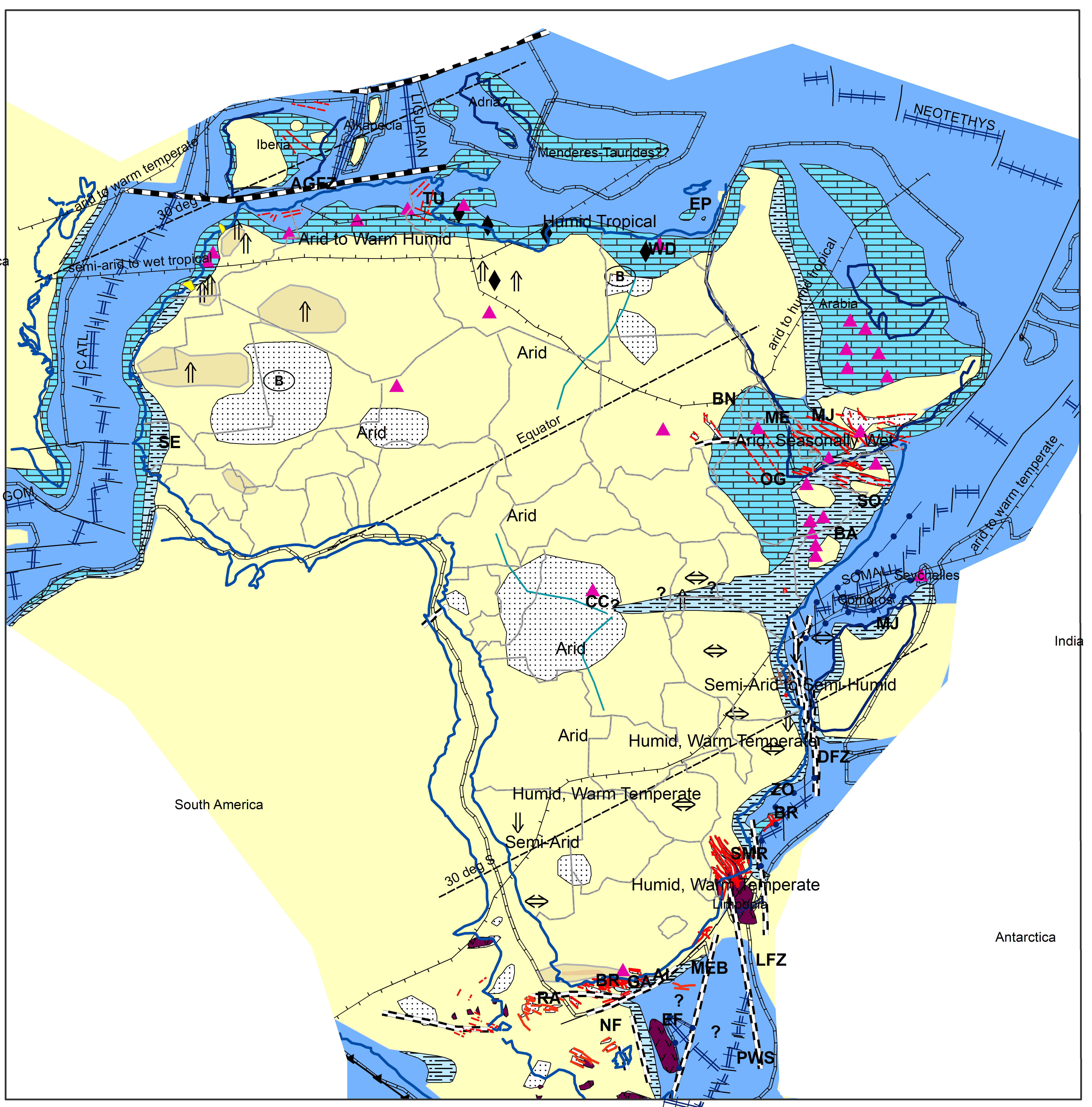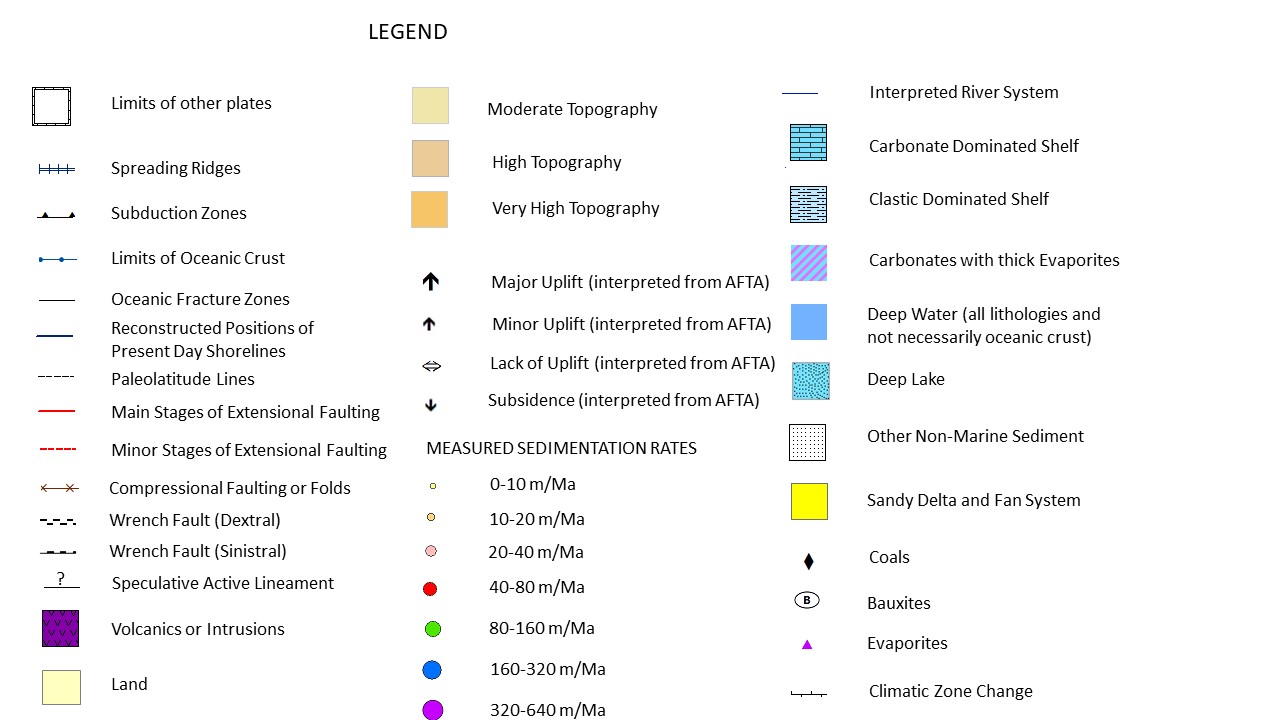This website is out of date and will shortly be deleted
Click here for new website and latest maps
Jurassic Paleotectonic and Paleogeographic Maps of Africa
Draft 3 March 2023
an ongoing project using the plate model of Colin Reeves (www.reeves.nl)
Comments welcomed
CLICK MAPS TO EXPANDCLICK REFERENCES FOR FULL DETAILS AND ACCESS
WATCH AT
watch at https://www.youtube.com/watch?v=YoNYyLGlxjA
Rhaetic/Hettangian ~ 200Ma
Most of the Eastern Mediterranean likely now opens. Major alkaline flood basalts of latest Triassic age are erupted in Israel and a large unconformity is seen there of Norian to Hettangian age (Gardosh et al, 2011). The available window for the age of the Eastern Mediterranean oceanic crust seems to be from late Triassic to early Middle Jurassic : a younger date is precluded by the opening of the Ligurian Ocean in the Middle Jurassic. Horsts and grabens in the Levantine Basin (LE) trend NNE-SSW , implying transform movement along the sharp Egyptian margin (Longacre et al, 2007: Tari et al, 2012). At some point, extension is transferred to the Herodotus (HE) Basin, which hyperextended, leaving the Eratosthenes High as a stranded block (Gao et al, 2020). This can be connected with evidence of transform tectonics in the Gulf of Sirt (GOS, Jagger et al, 2018). and as far as the incipient Azores-Gibraltar transform. However the Menderes-Taurides blocks cannot be moved too far west while holding Apulia in place (as evidenced by paleomagnetics) and the phase of NNE-SSW spreading may thus have been short lived
The intensity of rifting has decreased in the Newark (NE), Nova Scotia (NS), Atlassic (AT) and Sicilian rifts (SI), though a second milder pulse is proposed in Morocco (Frizon et al, 2008, Escoca et al, 2021). A major magmatic event occurs at the Triassic-Jurassic boundary, which is defined at the mass extinction associated with the Central Atlantic Magmatic Plume (CAMP). The distribution of these volcanics is largely after McHone (2000). Within tectonically controlled inlets such as the Triassic Basin (TR) and incipient Central Atlantic, evaporites are well developed. On the American side, there is magnetic evidence for the emplacement of seaward dipping reflectors around this time: the only reports of these on the African side come from presentations by Petrosen over Senegal.
The ‘Karoo’ rifts are now inactive (Macgregor (2018)). Over the Zambian and Tanzanian rifts, an unconformity is seen between Triassic and Late Cretaceous, capping inversion structures that increase in intensity to the SW. The lack of any displacement on Pleinsbachian dyke swarms suggest this inversion could be placed in this time period. This inversion could indicate a reversal of the STASS wrench faults.
Africa is still moving north over the climatic belts, including an expanded arid zone (Boucot, 2013) , although this movement is now slowing. Despite the widespread evaporites in north Africa, there are still indications of periodically humid conditions, particularly in NE Africa, where coals are developed (Boucot, 2013). Humid conditions become more frequent in NW Africa as one moves into the Jurassic (Olsen, 2000). Increasingly hot and arid conditions are evidenced in the Great Karoo (GK) Basin, with aeolian sandstones now being deposited (Catuneanu et al, 2005).
Pleinsbachian - Early Toarcian 185Ma
The Early Jurassic is marked by an expansion of oceanic crust around northern Africa. This stage lies within the allowable period for the formation of the Eastern Mediterranean and an initiation at this time would be consistent with the first phase of rifting of the Western Desert (WD) and a Pleinsbachian transgression accompanying this (Keeley and Massoud, 1998). Tugend at al (2019) conclude on the basis of palaeomagnetic data that Ionian Seas spreading was likely initiated in late Early to Middle Jurassic times. Deep marine environments are established by the Aalenian in Sicily (Catalano et al, 2013). model adopted for the opening of the Central Atlantic is that of Labails et al (2010), with first oceanic crust around 190Ma emplaced north of the Blake Spur only .
A new phase of rifting commences over East Africa, preceding opening of the Somali Oceanic Basin, perhaps as early as Toarcian (Reeves, 2018). Macgregor (2018) interprets early syn-rift condition in the Pleinsbachian over rifts such as the Mandawa (MA) Basin of Tanzania, preceding the main syn-rift conditions in the Toarcian. Early Jurassic rifts are also interpreted on seismic offshore Somalia (Davidson et al (2018)), which will go into hyperextension. Marine conditions transgressed in the Pleinsbachian as far south as southern Somalia, prior to of a northern derived marine transgression and salt deposition in the Toarcian Macgregor (2018), which likely reached Mozambique. Toarcian salt is known from the Mandawa (MA) Basin of Tanzania and the Majunga Basin (MJ) of Madagascar, while salt diapirs are interpreted on seismic in the offshore Angoche (AN) Basin of Mozambique (INP, 2023) . A major ‘Karoo’ volcanic episode affects southern Africa (Pevye 2015) , Antarctica and Tasmania in the earliest Toarcian (circa 179Ma) and is tied to a significant extinction event. The lack of any subsequent displacement on Botswanan and Namibian dykes of this age indicates that there have no transform displacements crossing this area at any time since. At 177Ma, volcanism began on the Mozambique margin (Mueller 2019) with the emplacement of seaward dipping reflectors.
The first AFTA-derived uplift interpretations start to appear though are not backed up by sedimentological data in offshore sinks, so are uncertain. The Reguibat massif of NW Africa may be starting a long slow topographic rise (Charton et al 2020) , though this is not reflected in any significant supply of coarse clastics to the adjoining margin. AFTA data alone also suggest an uplift of the Leo massif region (Wildman, 2022). There are relatively few climate datapoints for this interval, These indicate a continuation of the widespread arid conditions of the Late Triassic. Increasingly hyperarid conditions are indicated for the Great Karoo Basin (Bordy and Catuneanu, 2002)
Bajocian 170Ma
The Eastern Mediterranean/Ionian seas may be approaching the end of their drift phase by this time, as extension is now commencing in the Ligurian Sea (Handy et al, 2010). However, the presence of Middle Jurassic flood basalts on the western margins of the Ionian Sea (Reeh and Aifa, 2008) may suggest continued activity . The rate of drift is accelerating in the Central Atlantic, with oceanic crust now reaching south of the Blake Spur (BS) (Teasdale in Casson, 2020) . Sheridan (1988) interprets breakup on the Blake Plateau as basal Callovian.
Indian Ocean unzipping and spreading is far more rapid. The Somali Basin is now opening, with oblique spreading extending to Tanzania and perhaps northern Mozambique (Reeves, 2018). The Davie Transform is yet to form (Phethean, 2016). A major transgression is observed in many of these basins around Bajocian times, which may mark break up (Macgregor (2018)). A volcanic margin is forming over the Mozambique margin. Figuerido et al (PESGB presentation, 2021) interprets first oceanic crust at 170Ma in the Angoche (AN) Basin and offshore Zambezi (ZA) , though this was abandoned in favour of more outboard spreading centre 10My later, leaving the Beira High (BH) as a stranded block. Roche et al (2023) transfers the extension in this region to the south on a large transform , where the proto-Weddell Sea could be opening. Rifting of the Agulhas Basins in South Africa may be commencing in the deepest half graben of the Gamtoos (GA) Basin (Mcmillan et al, 1997). This is likely to be an extension of the East Falklands (EF) Basin, where a very thick Jurassic section seems to open up over major bounding faults in a possible pull-apart setting.
The Middle Jurassic is a relatively inactive period with respect to intra-plate rifting . A notable exception is a second phase of rifting in the Western Desert (WD) (Dolson et al, 2014). This and later phases of Western Desert rifting are difficult to explain in a geodynamic framework : a SE Asia style model involving initial transtension (and later reversal and transpression), perhaps related to the Trans-African Lineament (TAL), can be speculated upon. Minor rifting continues in the northernmost Atlas Basins (Escoca et al, 2021), probably associated with sinistral movement on the Agulhas transform.
On a plate scale, carbonate deposition has become more widespread. Opposing carbonate platforms are now developed on the two Central Atlantic margins. The earliest transgressions in East Africa are marked by the formation of carbonates, particularly in the Bajocian, when opposing carbonate platforms formed in Tanzania/Kenya and Madagascar (Macgregor (2018). Relatively little climatic information is available in this time interval, though what is available suggests a continuation of the dominantly arid conditions of the Early Jurassic. Exceptions are increasingly humid conditions present in northern Africa, close to the Tethys ocean (e.g. coal development in the Western Desert). The only evidence for high topography gain comes from AFTA over NW Africa and the Leo Massif and is not supported by the presence of any clastic influxes to adjoining margins.
Kimmeridgian 155Ma
Most Tethyan oceans from the Proto-Caribbean to the Middle East are now rapidly spreading, as are various segments of the Indian Ocean. A switch to N-S spreading in the Somali Basin initiates the Davie Transform (DT), which is entirely developed within oceanic crust (e.g. Pheathan, 2016). A correlation of organic shales at this level between DSDPs on the Maurice Ewing Bank (MEB) to those in the Algoa (AL) and Gamtoos (GA) Basins fixes the relative positions of the African and South American plates at this time, supporting the reconstruction of Lovecchio et al, 2020. There is no marine strata seen in any of the basins north and west of the Falklands so the marine link in the Agulhas Basins has to come from areas east of the islands. The first marine strata are encountered in the Gamtoos Basin in the Kimmeridgian while marine strata are not seen in the Bredasdorp (BR) Basin to the west till the Tithonian (Mcmillan et al, 1997). A suggested early movement on the Agulhas transform later in the Jurassic probably therefore brought East Falklands Basin waters into contact with the Bredasdorp Basin. A series of rifts are also thought to become active in southern Mozambique at this time (Salman and Abdula, 1995) and could have a common origin. The geodynamic model for the East Falklands Basin remains uncertain. An oceanic crust base is suggested by Eagles and Eisermann (2020), though a reported significant crustal thickness seems incompatible with such a model. The alternative model is that of a pull apart basin.
NW-SE trending rifts become active in Yemen at this time but exploration for these in Somalia has failed to find thick Jurassic sections (Purcell, 2018).
There is little evidence, either direct or indirect, for significant topography development in Africa during the Late Jurassic, other than some topography previously described from NW Africa. The widespread nature of transgressions, related to high global sea level at this time, is indicative of low topography. A wide carbonate-prone transgression of central eastern Africa occurs, encompassing the Blue Nile gorge and in the Mekele inlier (ME, Alemu et al 2018). Papers in de Wit (2015) tentatively interpret Kimmeridgian shallow marine environments as far inland as the Cuvette Centrale (CC) of the DR Congo. Carbonate deposition dominates all northern regions of the African plate, while the south-western margins are clastic dominated, though without evidence of any major deltas. Paleoclimatic data (Myers et al, 2011: Boucot et al, 2013) indicates three clear zones namely, humid tropical conditions on the East Mediterranean margin, widespread arid conditions in the interior and humid and warm temperate conditions in the south and south-westKey References (incomplete at this stage)
Boucot Arthur J. Xu Chen, Christopher R. Scotese, Robert J. Morley. “Phanerozoic Paleoclimate; an Atlas of Lithologic Indicators of Climate.” Concepts in Sedimentology and Paleontology 11 (October 2013) https://pubs.geoscienceworld.org/sepm/books/book/1966/Phanerozoic-PaleoclimateAn-Atlas-of-Lithologic
Casson, M. 2020, Cretaceous continental margin evolution revealed using quantitative seismic geomorphology, offshore northwest Africa, Basin Research, 33, 1, 66-90 https://onlinelibrary.wiley.com/doi/10.1111/bre.12455
Dolson J., Atta, M. Blanchard, D. et al et al, 2014, Egypt's future petroleum resources: A revised look in the 21st Century , AAPG Memoir, 143-178, https://archives.datapages.com/data/specpubs/memoir106/data/143_aapg-sp1960143.htm?q=%2BauthorStrip%3Adolson
Escoca F.O , Lepretre, R., Spina, V., Gimeno-Vives O., Kergavarat, C., Mohn, G and Frizon de Lamotte, D. Vives, 2021, Polyphased Mesozoic rifting from the Atlas to the north-west Africa palaeomargin, Earth Science Reviews, 220, 103732, www.sciencedirect.com/science/article/pii/S0025322720301547
Figuerido P. , McDermott, C., and Glover, C, 2021, Tectonic Domains and Evolution of the Southern Mozambique Margin: Implications for Jurassic Paleogeography and Hydrocarbon Systems, PESGB Africa Conference Presentation
Gao H. , Wen, Z. SHI, b, Wang, Z and Song C. , 2020 , Tectonic characteristics of the Eratosthenes Seamount and its periphery: Implications for evolution of the eastern Mediterranean, Marine Geology, 428, 106266, www.sciencedirect.com/science/article/pii/S0025322720301547
Handy, M.R, Schmid, S.M, Bousquet, R, Kissling, E. and Bernoulli, D. , 2010, Reconciling plate-tectonic reconstructions of Alpine Tethys with the geological–geophysical record of spreading and subduction in the Alps, Earth Science Reviews, 102, 3-4, 121-158 , www.sciencedirect.com/science/article/pii/S0012825210000668
Jagger, LJ, Bevan, TG & McClay, KR 2018, ‘Tectono-stratigraphic evolution of the SE Mediterranean passive margin, offshore Egypt and Libya’, Special Publication - Geological Society of London, vol. 476 www.lyellcollection.org/doi/abs/10.1144/SP476.10
Labails, C, Olivet, J-L, Aslanian, D & Roest, WR 2010, ‘An alternative early opening scenario for the central Atlantic Ocean’, Earth and Planetary Science Letters, vol. 297, no. 3–4, pp. 355–368 https://www.sciencedirect.com/science/article/pii/S0012821X10003997
Lovecchio,J.P, S Rohais, P Joseph, ND Bolatti, VA Ramos. 2020, Mesozoic rifting evolution of SW Gondwana: a poly-phased, subduction-related, extensional history responsible for basin formation along the Argentinean Atlantic margin, Earth-Science Reviews 203, 103138, www.sciencedirect.com/science/article/pii/S0012825219305926
Macgregor, D 2018, ‘History of the development of Permian-Cretaceous rifts in East Africa; a series of interpreted maps through time’, Petroleum Geoscience, vol. 24, no. 1, pp. 8–20 https://www.lyellcollection.org/doi/10.1144/petgeo2016-155
McHone J.G., 2000, Non-plume magmatism and rifting during the opening of the central Atlantic ocean, Tectonophysics 316 (2000) 287-296 www.sciencedirect.com/science/article/pii/S0040195199002607
Mcmillan, I.K, Brink, G.I, Broad, D.S and Maier, J.J, 1997, Late
Mesozoic Sedimentary Basins off the south coast of South Africa , Sedimentary
Basins of the Worlkd, 3, 1997, 319-276 www.sciencedirect.com/science/article/pii/S1874599797800160
Mueller, C.O, 2019 and Jokat, W, 2019, The initial Gondwana break-up: A synthesis based on new potential field data of the Africa-Antarctica Corridor, Tectonophysics, 750, 301-328 www.sciencedirect.com/science/article/pii/S0040195118303858
Myers, T. , Tabor, N.J and Jacobs, L.L, 2011, Late Jurassic paleoclimate of Central Africa, Palaeogeography, Palaeoclimatology, Palaeoecology, 311, 1-2 , 111-125 www.sciencedirect.com/science/article/pii/S0031018211004500
Pheathan J. Kalnins, L., van Hunen, J , et al , 2016, Madagascar's escape from Africa: A high-resolution plate reconstruction for the Western Somali Basin and implications for supercontinent dispersal, Geochemistry, Geophysics, Geosystems, 17, 12 https://agupubs.onlinelibrary.wiley.com/doi/epdf/10.1002/2016GC006624
Reeves, C, 2018, The development of the East African margin during Jurassic and Lower Cretaceous times: a perspective from global tectonics, Petroleum Geoscience Volume 24Pages 41 – 56 www.lyellcollection.org/doi/10.1144/petgeo2017-021
